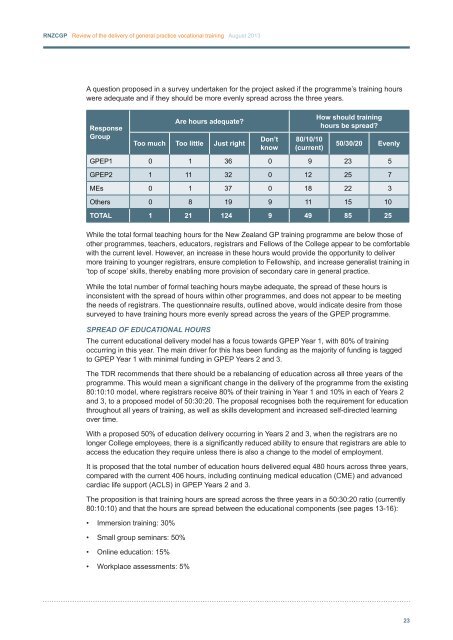AUGUST 2013 - New Zealand Doctor
AUGUST 2013 - New Zealand Doctor
AUGUST 2013 - New Zealand Doctor
You also want an ePaper? Increase the reach of your titles
YUMPU automatically turns print PDFs into web optimized ePapers that Google loves.
RNZCGP Review of the delivery of general practice vocational training August <strong>2013</strong>A question proposed in a survey undertaken for the project asked if the programme’s training hourswere adequate and if they should be more evenly spread across the three years.ResponseGroupAre hours adequate?Too much Too little Just rightDon’tknow80/10/10(current)How should traininghours be spread?50/30/20 EvenlyGPEP1 0 1 36 0 9 23 5GPEP2 1 11 32 0 12 25 7MEs 0 1 37 0 18 22 3Others 0 8 19 9 11 15 10TOTAL 1 21 124 9 49 85 25While the total formal teaching hours for the <strong>New</strong> <strong>Zealand</strong> GP training programme are below those ofother programmes, teachers, educators, registrars and Fellows of the College appear to be comfortablewith the current level. However, an increase in these hours would provide the opportunity to delivermore training to younger registrars, ensure completion to Fellowship, and increase generalist training in‘top of scope’ skills, thereby enabling more provision of secondary care in general practice.While the total number of formal teaching hours maybe adequate, the spread of these hours isinconsistent with the spread of hours within other programmes, and does not appear to be meetingthe needs of registrars. The questionnaire results, outlined above, would indicate desire from thosesurveyed to have training hours more evenly spread across the years of the GPEP programme.Spread Of Educational HoursThe current educational delivery model has a focus towards GPEP Year 1, with 80% of trainingoccurring in this year. The main driver for this has been funding as the majority of funding is taggedto GPEP Year 1 with minimal funding in GPEP Years 2 and 3.The TDR recommends that there should be a rebalancing of education across all three years of theprogramme. This would mean a significant change in the delivery of the programme from the existing80:10:10 model, where registrars receive 80% of their training in Year 1 and 10% in each of Years 2and 3, to a proposed model of 50:30:20. The proposal recognises both the requirement for educationthroughout all years of training, as well as skills development and increased self-directed learningover time.With a proposed 50% of education delivery occurring in Years 2 and 3, when the registrars are nolonger College employees, there is a significantly reduced ability to ensure that registrars are able toaccess the education they require unless there is also a change to the model of employment.It is proposed that the total number of education hours delivered equal 480 hours across three years,compared with the current 406 hours, including continuing medical education (CME) and advancedcardiac life support (ACLS) in GPEP Years 2 and 3.The proposition is that training hours are spread across the three years in a 50:30:20 ratio (currently80:10:10) and that the hours are spread between the educational components (see pages 13-16):• Immersion training: 30%• Small group seminars: 50%• Online education: 15%• Workplace assessments: 5%23
















